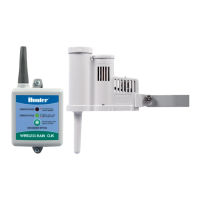Valve 4 (18.9 GPM)
Operating pressure = 50 psi
32
Calibrating the Flow-Clik™ to the
Irrigation System
Using the Flow-Clikʼs Interface Box, the sensor is
calibrated by pressing the Calibrate button while the
highest flow zone is operating. While the system is
“learning” the flow, the System Status Indicator light
will be yellow. After a 10 second period of “learning” it
will begin to monitor system flow.
If you already know the highest flow zone within
the system:
1. Turn the Startup Delay dial to the 0 second position.
2. Turn the Interrupt Period dial to the Sensor Bypass/
Calibrate position.
3. Manually activate the zone with the highest flow.
4. While the zone is operating, press and hold the
Calibrate button on the Interface Box. The System
Status Indicator light will change to yellow indicat-
ing that the sensor is being calibrated to the zone(s)
operating. Release the calibrate button. Once the
Flow-Clik has finished “learning” the systemʼs high
flow zone, the light will turn to flashing green which
means that the calibration process is complete.
5. Turn the irrigation system off and set the Startup De
-
lay and Interrupt Period settings on the Interface Box
(see Setting the Startup Delay and Interrupt Period).
If you do not know the highest flow zone within
the system:
Flow Estimate Calibration Method
In some cases, you may not know the zone with the
highest flow. A guideline that will help you easily de-
termine which zone valve has the highest flow (GPM)
is to count the number of sprinklers on each zone. If
there are zones with both sprays and rotors operating in
the irrigation system, you can multiply each spray head
by 2.0 GPM, each medium range rotor by 4.0 GPM,
and each large range rotor by 15.0 GPM for a general
estimate of total flow for each zone.
For a more accurate determination of total flow for
each zone, it is recommended that you measure the
nozzle pressure at each sprinkler zone and then look up
the nozzle flow at that specific pressure in the nozzle
performance data section of the manufacturer product
catalog. Once a determination is made of the highest
flow zone, you can use the procedure above to calibrate
the Flow-Clik to the system.
For example, Figure 1 shows a typical zone using I-20
rotors. To estimate the total flow of the zone:
1. Determine the approximate water pressure at the base
of the sprinklers in each zone while the system is
operating. In the illustrative example it has been deter-
mined that the sprinkler pressure in zone 4 is 50 psi.
2. Identify the model of sprinkler and its associated
nozzle for each valve. Valve 4 has Hunter I-20
rotors that have various nozzles based on the dis-
tance of throw and the arc of coverage needed. For
reference, the quantities of each type of sprinkler
and nozzle configuration for zone 4 is identified in
the attached irrigation legend.
3. Determine the flow rate for each sprinkler and
nozzle configuration. Based upon information found
in the Hunter Catalog the associated flows for each
Hunter I-20 sprinkler and nozzle configuration is
listed in the attached irrigation legend.
4. Determine the total flow of all sprinklers on the
zone. The total flow of zone 4 in this example is
18.9 GPM as identified in the irrigation legend.
Symbol Sprinkler Description *Flow
@ 50 psi
Qty Total
Flow
Hunter I-20-ADS – 1.5 1.6 x 3 = 4.8
Hunter I-20-ADS – 3.0 2.7 x 2 = 5.4
Hunter I-20-ADS – 4.0 4.2 x 1 = 4.20
Hunter I-20-ADS – .75SR .75 x 2 = 1.50
Hunter I-20-ADS – 1.5SR 1.5 x 2 = 3.0
Total Flow = 18.9 GPM
*Information obtained from the Hunter catalog, LIT-060
Figure 1 Legend
INSTALLATION INSTRUCTIONS (continued)

